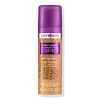What's inside
What's inside
 Key Ingredients
Key Ingredients

 Benefits
Benefits

 Concerns
Concerns

 Ingredients Side-by-side
Ingredients Side-by-side

Water
Skin ConditioningCyclopentasiloxane
EmollientGlycerin
HumectantPhenyl Trimethicone
Skin ConditioningTrimethylsiloxysilicate
EmollientAcetyl Glucosamine
Skin ConditioningNiacinamide
SmoothingSodium Chloride
MaskingAluminum Starch Octenylsuccinate
AbsorbentPEG/PPG-18/18 Dimethicone
EmulsifyingMica
Cosmetic ColorantAmmonium Acrylates Copolymer
Phenoxyethanol
PreservativeTocopheryl Acetate
AntioxidantPanthenol
Skin ConditioningCaprylyl Glycol
Emollient1,2-Hexanediol
Skin ConditioningSodium Benzoate
MaskingAlcohol Denat.
AntimicrobialDimethicone
EmollientMethicone
EmollientDisodium Deceth-6 Sulfosuccinate
CleansingTocopherol
AntioxidantLaureth-30
CleansingCocos Nucifera Oil
MaskingGlycine Soja Oil
EmollientAloe Barbadensis Leaf Juice
Skin ConditioningSodium Dehydroacetate
PreservativePentylene Glycol
Skin ConditioningCocos Nucifera Fruit Extract
EmollientPEG-60 Hydrogenated Castor Oil
EmulsifyingCitric Acid
BufferingFructose
HumectantSodium Hydroxide
BufferingUrea
BufferingAllantoin
Skin ConditioningMaltose
MaskingSodium Lactate
BufferingSodium PCA
HumectantTrehalose
HumectantPhenethyl Alcohol
MaskingPotassium Sorbate
PreservativeGlucose
HumectantSilybum Marianum Seed Extract
Skin ConditioningSodium Hyaluronate
HumectantHelianthus Annuus Seed Oil
EmollientRosmarinus Officinalis Leaf Extract
AntimicrobialLimonene
PerfumingLinalool
PerfumingCI 77891
Cosmetic ColorantIron Oxides
Water, Cyclopentasiloxane, Glycerin, Phenyl Trimethicone, Trimethylsiloxysilicate, Acetyl Glucosamine, Niacinamide, Sodium Chloride, Aluminum Starch Octenylsuccinate, PEG/PPG-18/18 Dimethicone, Mica, Ammonium Acrylates Copolymer, Phenoxyethanol, Tocopheryl Acetate, Panthenol, Caprylyl Glycol, 1,2-Hexanediol, Sodium Benzoate, Alcohol Denat., Dimethicone, Methicone, Disodium Deceth-6 Sulfosuccinate, Tocopherol, Laureth-30, Cocos Nucifera Oil, Glycine Soja Oil, Aloe Barbadensis Leaf Juice, Sodium Dehydroacetate, Pentylene Glycol, Cocos Nucifera Fruit Extract, PEG-60 Hydrogenated Castor Oil, Citric Acid, Fructose, Sodium Hydroxide, Urea, Allantoin, Maltose, Sodium Lactate, Sodium PCA, Trehalose, Phenethyl Alcohol, Potassium Sorbate, Glucose, Silybum Marianum Seed Extract, Sodium Hyaluronate, Helianthus Annuus Seed Oil, Rosmarinus Officinalis Leaf Extract, Limonene, Linalool, CI 77891, Iron Oxides
Water
Skin ConditioningGlycerin
HumectantHexyl Laurate
EmollientPropanediol
SolventOctyldodecanol
EmollientPentylene Glycol
Skin ConditioningBenzyl Alcohol
PerfumingBakuchiol
AntimicrobialDisteardimonium Hectorite
StabilisingAluminum Hydroxide
EmollientCarbomer
Emulsion StabilisingAmodimethicone
Propylene Carbonate
SolventTrisodium Ethylenediamine Disuccinate
Acrylates/C10-30 Alkyl Acrylate Crosspolymer
Emulsion StabilisingSodium Lauroyl Glutamate
Lysine
Skin ConditioningSodium Hydroxide
BufferingAlcaligenes Polysaccharides
EmollientMagnesium Chloride
Tranexamic Acid
AstringentWater, Glycerin, Hexyl Laurate, Propanediol, Octyldodecanol, Pentylene Glycol, Benzyl Alcohol, Bakuchiol, Disteardimonium Hectorite, Aluminum Hydroxide, Carbomer, Amodimethicone, Propylene Carbonate, Trisodium Ethylenediamine Disuccinate, Acrylates/C10-30 Alkyl Acrylate Crosspolymer, Sodium Lauroyl Glutamate, Lysine, Sodium Hydroxide, Alcaligenes Polysaccharides, Magnesium Chloride, Tranexamic Acid
 Reviews
Reviews

Ingredients Explained
These ingredients are found in both products.
Ingredients higher up in an ingredient list are typically present in a larger amount.
Glycerin is already naturally found in your skin. It helps moisturize and protect your skin.
A study from 2016 found glycerin to be more effective as a humectant than AHAs and hyaluronic acid.
As a humectant, it helps the skin stay hydrated by pulling moisture to your skin. The low molecular weight of glycerin allows it to pull moisture into the deeper layers of your skin.
Hydrated skin improves your skin barrier; Your skin barrier helps protect against irritants and bacteria.
Glycerin has also been found to have antimicrobial and antiviral properties. Due to these properties, glycerin is often used in wound and burn treatments.
In cosmetics, glycerin is usually derived from plants such as soybean or palm. However, it can also be sourced from animals, such as tallow or animal fat.
This ingredient is organic, colorless, odorless, and non-toxic.
Glycerin is the name for this ingredient in American English. British English uses Glycerol/Glycerine.
Learn more about GlycerinPentylene glycol is typically used within a product to thicken it. It also adds a smooth, soft, and moisturizing feel to the product. It is naturally found in plants such as sugar beets.
The hydrophilic trait of Pentylene Glycol makes it a humectant. As a humectant, Pentylene Glycol helps draw moisture from the air to your skin. This can help keep your skin hydrated.
This property also makes Pentylene Glycol a great texture enhancer. It can also help thicken or stabilize a product.
Pentylene Glycol also acts as a mild preservative and helps to keep a product microbe-free.
Some people may experience mild eye and skin irritation from Pentylene Glycol. We always recommend speaking with a professional about using this ingredient in your routine.
Pentylene Glycol has a low molecular weight and is part of the 1,2-glycol family.
Learn more about Pentylene GlycolSodium Hydroxide is also known as lye or caustic soda. It is used to adjust the pH of products; many ingredients require a specific pH to be effective.
In small amounts, sodium hydroxide is considered safe to use. However, large amounts may cause chemical burns due to its high alkaline.
Your skin has a natural pH and acid mantle. This acid mantle helps prevent harmful bacteria from breaking through. The acid mantle also helps keep your skin hydrated.
"Alkaline" refers to a high pH level. A low pH level would be considered acidic.
Learn more about Sodium HydroxideWater. It's the most common cosmetic ingredient of all. You'll usually see it at the top of ingredient lists, meaning that it makes up the largest part of the product.
So why is it so popular? Water most often acts as a solvent - this means that it helps dissolve other ingredients into the formulation.
You'll also recognize water as that liquid we all need to stay alive. If you see this, drink a glass of water. Stay hydrated!
Learn more about Water